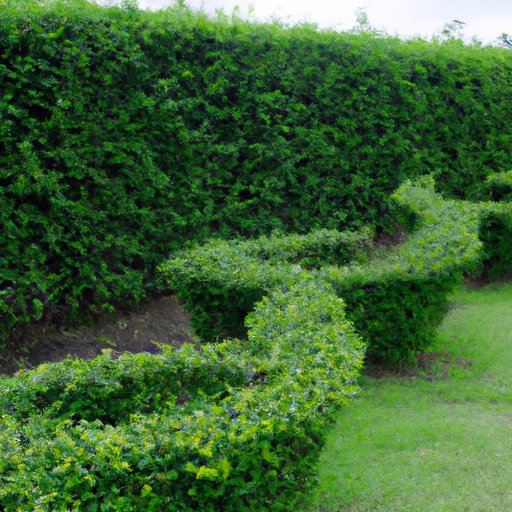Introduction
Trimming bushes is an important gardening chore that can help maintain an attractive landscape and keep plants healthy. But when is the best time to trim bushes? That depends on the type of bush you are pruning and other factors, such as season and weather. In this article, we’ll explore the best time of year to trim bushes, how pruning at the right time enhances bush appearance, benefits of properly timed pruning for healthy bushes, tips for pruning different types of bushes, what to consider before trimming bushes, and strategies for pruning bushes for maximum aesthetic impact.

Identifying the Best Time of Year to Trim Bushes
The best time of year to trim bushes depends on a variety of factors, including the type of bush, the climate, and the desired results. Generally speaking, the optimal window for pruning most bushes is from late winter to early spring, just before new growth begins. However, there are some exceptions, as certain types of bushes may require pruning at different times of year.
Special Considerations for Different Types of Bushes
For example, deciduous shrubs, which lose their leaves in winter, should be pruned in late winter or early spring before they begin to bud. Flowering shrubs, on the other hand, should be pruned immediately after they finish blooming, typically in summer or fall. Evergreen shrubs should be pruned in late winter or early spring, while ornamental grasses should be trimmed back in late winter or early spring. Hedges should be pruned twice a year, once in late winter or early spring and again in mid-summer.
How Pruning at the Right Time of Year Enhances Bush Appearance
Pruning bushes at the right time of year can have a significant impact on their appearance. Properly timed pruning can result in improved aesthetics, as it encourages plants to grow fuller and more evenly. Pruning at the wrong time of year, on the other hand, can result in stunted growth and unbalanced shapes.
Pruning at the right time of year can also improve the resilience of the bush. Pruning in late winter or early spring gives the bush time to recover from the shock of pruning before the harsh summer months, when temperatures and humidity can take a toll on plants. Pruning during the summer months, on the other hand, can leave plants vulnerable to damage from extreme heat.

Benefits of Properly Timed Pruning for Healthy Bushes
In addition to enhancing the appearance of bushes, timing pruning correctly has many other benefits for the health of the plant. Pruning at the right time of year can stimulate new growth and encourage healthier branches and leaves. It can also help control the size and shape of the bush and reduce the risk of disease.
Tips for Pruning Different Types of Bushes
When it comes to pruning bushes, there are a few general tips that apply to all types of plants. First, always use sharp, clean tools to avoid damaging the plant. Second, make sure to prune away any dead, diseased, or damaged branches. Finally, never remove more than one-third of the plant’s total foliage at one time.
When pruning different types of bushes, there are a few additional considerations to keep in mind. Flowering shrubs should be pruned immediately after they finish blooming, as this will ensure that the next season’s flowers will be full and vibrant. Evergreen shrubs should be pruned in late winter or early spring, as this will encourage new growth and a fuller shape. Ornamental grasses should be trimmed back in late winter or early spring to prevent them from becoming too tall or unruly. Hedges should be pruned twice a year, once in late winter or early spring and again in mid-summer.

What to Consider Before Trimming Bushes
Before beginning any pruning project, it’s important to assess the bush to determine the best course of action. Start by identifying the type of bush you are pruning, as this will help guide your decisions. Next, evaluate the size and shape of the bush, as well as its overall health. Look for any signs of disease, pests, or damage that may need to be addressed.
The Right Time for Pruning Trees and Shrubs
Trees and shrubs require slightly different pruning schedules due to their different growth cycles. Trees should generally be pruned in late winter or early spring, as this is when they are dormant and less vulnerable to damage. Shrubs, on the other hand, should be pruned in late winter or early spring, as this is when they are actively growing and more resilient to pruning.

Strategies for Pruning Bushes for Maximum Aesthetic Impact
When pruning bushes for maximum aesthetic impact, it’s important to use a combination of techniques. Selective pruning, which involves removing individual branches or stems, is often used to create a desired shape or size. Creative pruning, on the other hand, involves removing entire sections of the bush to create a customized look. Both techniques can be used to create a beautiful, balanced bush.
Conclusion
Trimming bushes at the right time of year can have a dramatic impact on their appearance and health. The best time to prune depends on the type of bush and other factors, such as the climate and the desired results. For most bushes, the optimal window for pruning is from late winter to early spring. Other types of bushes may require pruning at different times of year. When pruning bushes for maximum aesthetic impact, it’s important to use a combination of techniques, such as selective and creative pruning.


